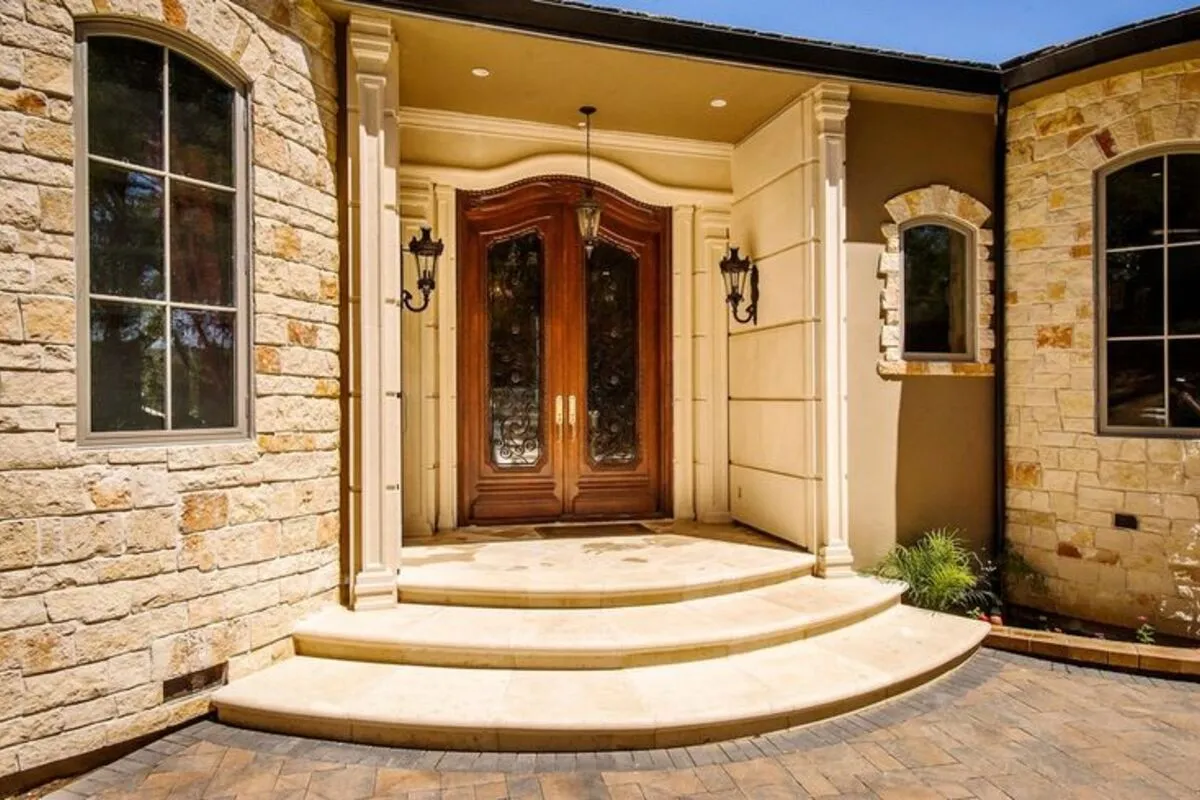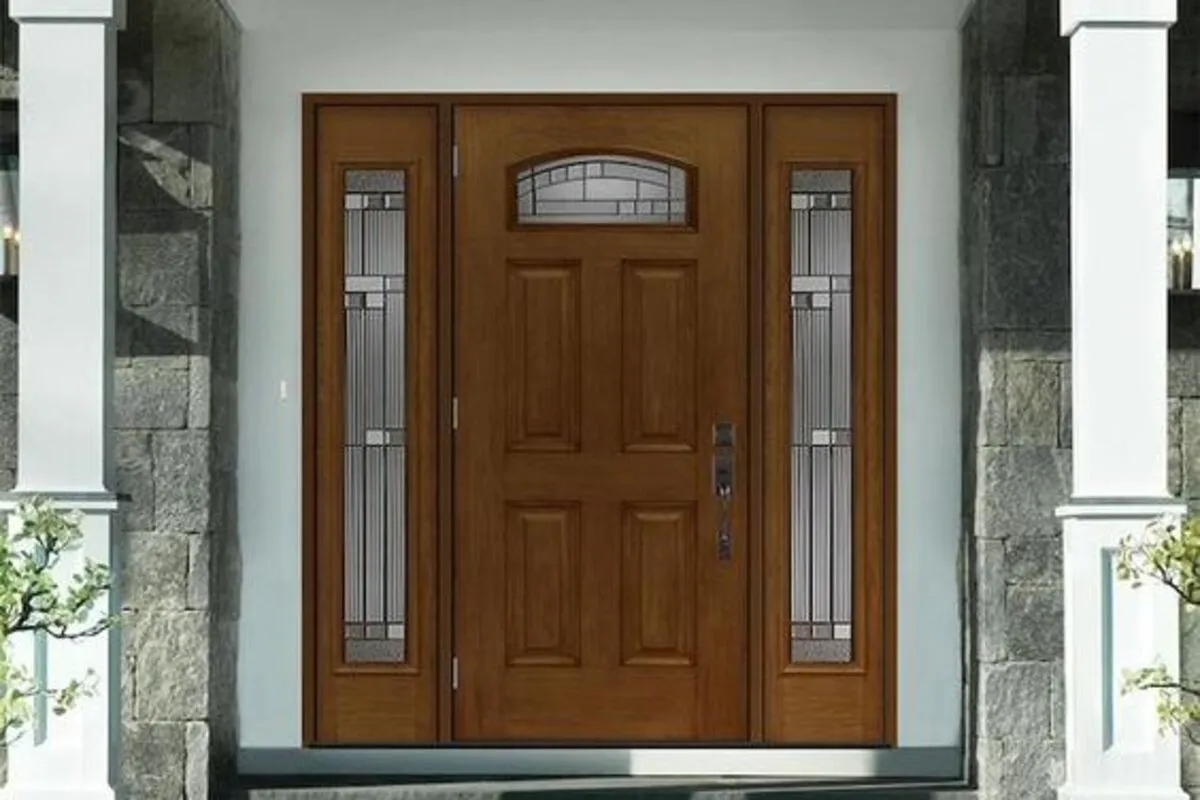Have you ever faced the dilemma of sprucing up your existing door or replacing it entirely? This article sheds light on door refinishing as a savvy alternative that marries cost-efficiency with aesthetic revival.
Door refinishing offers cost-effective aesthetic enhancement, preserving doors’ integrity and increasing home value. Sustainable practices reduce environmental impact, while DIY options save money. Understand the process, materials, and benefits of a successful makeover.
Discover through our exploration how refinishing extends the life of your doors and uplifts your home’s charm without the hefty replacement price tag. Explore a realm where sustainability meets beauty, and let us guide you through the transformative power of refinishing your doors. Ready to unlock the secrets behind a successful door makeover? Keep reading.
The Aesthetic Appeal of Refinished Doors
Refinishing doors offer a transformation that breathes new life into your home’s entrance, enhancing its beauty and ambiance. The process revives the door’s surface and allows customization to fit your home’s unique style.
Whether aiming for a modern look or preserving historical charm, door refinishing makes it possible without the high costs associated with replacement. This approach ensures that your doors match your home’s aesthetic, significantly impacting your home’s overall appeal.
Transforming Your Home with Door Refinishing
A simple door refinishing project can drastically change the look of your home, making it more inviting and appealing. It’s a cost-effective way to update doors, improve curb appeal, and potentially increase your home’s value. This transformation is not just about looks; it also adds to the longevity of your doors, protecting them against the elements and daily wear. Refinishing can turn an old, worn-out door into a stunning entry point that complements your home’s design.
The Refinishing Process
- Assessment of Door Condition Before beginning, it’s essential to assess the door’s current state. This step determines whether refinishing is viable or if replacement is the better option. Factors such as structural integrity and material type are considered.
- Selection of Materials and Tools Choosing the right materials and tools is crucial for a successful refinishing job. This includes selecting the appropriate paint or stain, sanding equipment, and sealants that best complement the door’s material and withstand weather conditions.
Read it: Four Benefits Of Professional Wood Door Refinishing In Atlanta
- The Cleaning and Sanding Phase A thorough cleaning removes dirt and grime, while sanding prepares the surface by smoothing imperfections. This step ensures the new finish adheres properly and looks smooth.
- Staining or Painting: Applying the stain or paint revitalizes the door’s look, allowing for a complete transformation or subtle update. This stage is where the door’s new aesthetic begins to take shape, offering a refresh to its appearance.
- Final Sealing and Protection: The last step involves sealing the door with a protective coat to ensure its durability, moisture, and sun damage resistance. This protection keeps the door looking great for years, making door refinishing a wise investment.
The Environmental Impact of Door Refinishing
Door refinishing is a beacon of environmental responsibility in home renovation. This process significantly reduces the demand for new materials, diminishing the environmental footprint associated with door replacement.

Sustainable indoor refinishing practices encompass using eco-friendly paints and stains with lower VOC levels, contributing to better indoor air quality and less environmental harm. Furthermore, refinishing curtails the waste cycle by extending the life of existing doors, ensuring doors serve their purpose longer before reaching landfills.
Table: Environmental Impact of Door Refinishing vs. New Installation
| Impact Area | Refinishing | New Installation | Notes |
| Material Waste | Low | High | Refinishing minimizes waste by extending the lifespan of existing doors. New installations create construction waste from discarded doors. |
| Energy Consumption | Low | High | Refinishing requires less energy compared to manufacturing and transporting new doors. |
| Chemical Usage | Moderate | High | Refinishing involves some chemicals (stripper, stain, paint). New |
Upcycle Your Doors: Sustainable and Cost-Effective Refinishing
Upcycling your doors through refinishing is not just an act of home improvement but a step towards sustainable living. This method allows homeowners to revive their doors without needing replacement, showcasing the beauty of renewal with minimal environmental impact.
Read it: Residential Front Door Repair and its 16 signs in Atlanta
Upcycling is a cost-effective solution, bypassing the expenses associated with purchasing new doors while also contributing to reducing waste. It embodies a sustainable and budget-friendly approach to home decor, aligning with eco-conscious values.
Economic Insights: Door Refinishing vs. Replacement
When considering door refinishing vs replacement cost, it’s clear that refinishing is the more economical. The process involves labor and materials for sanding, painting, staining, and sealing, which generally incurs lower costs than acquiring and installing a new door.
Detailed cost analysis reveals that refinishing can save homeowners up to 50% over replacement, depending on the door’s condition and desired outcome. This cost-efficiency, paired with the aesthetic flexibility refinishing offers, makes it an attractive option for those looking to enhance their home’s appearance without a hefty investment.
Is It Cheaper to Refinish or Replace Doors?
Real-life case studies underscore the cost-effectiveness of door refinishing. Refinishing is the more economical route in scenarios where doors possess solid structure but superficial wear. The costs associated with door replacement include the new door and hardware, installation, and potential modifications to the frame or structure, which can quickly add up.
In contrast, refinishing utilizes existing materials and focuses on restoration, making it a notably more affordable door makeover option. This evidence firmly supports refinishing as a cost-effective way to update doors, offering significant savings alongside aesthetic enhancement.
Technical Deep explore into Door Refinishing
Selecting the right materials is crucial in the door refinishing process, as it directly impacts the appearance and longevity of the door. Stains are often used for wooden doors to enhance their natural grain, offering a range of colors from light to dark.
Read it: Weatherproof Your Doors: Essential Repairs for Atlanta’s Climate
Paints provide a more diverse color palette and can completely transform a door’s look. Finishes, including polyurethane, varnish, and lacquer, are applied last to protect the door from environmental damage and wear. Each material is pivotal in achieving the desired outcome, balancing aesthetics with functionality.
The Technical Aspects of Door Sanding
Sanding is a preparatory step that cannot be overlooked when refinishing. Proper sanding ensures that stains, paints, and finishes adhere well and that the final result is smooth and free of imperfections. The best practice involves starting with coarse-grit sandpaper to remove old finishes and then progressively moving to finer grits for a smooth surface.

Special attention should be given to maintaining the integrity of the door’s design elements during sanding. This meticulous preparation is essential for a high-quality door refinishing job.
The Science Behind Door Staining and Painting
The techniques used in staining and painting doors play a significant role in refinishing. Staining requires a careful application to achieve an even finish that showcases the wood’s natural beauty. The type of wood influences the stain’s absorption rate and final color.
Painting allows for more creativity and uniformity, especially on less ideal door surfaces. Oil-based and water-based paints affect drying time, durability, and environmental impact. Understanding these nuances ensures that the refinished door meets aesthetic and durability standards.
Technicalities of Sealing and Finishing a Door
The final step in door refinishing involves sealing and finishing, which protects the door from moisture, sunlight, and daily use. The selection of sealant or finish depends on the door’s location (interior vs. exterior) and the desired sheen (matte, satin, semi-gloss, or gloss).
Application techniques vary; some prefer brushes for detail work, and others use sprayers for a more even coat. This phase is critical for ensuring the door’s longevity and resistance to the elements, encapsulating the art and science of door refinishing in preserving the door’s newly rejuvenated appearance.
Step One: Preparation and Safety
Preparing the workspace and ensuring safety is crucial before embarking on a DIY door refinishing project. Gather all necessary materials and tools, including sandpaper, stain or paint, brushes, and a sealant.
Read it: Four Reasons To Hire Door 4 Life Wood Refinishing Professionals
Wear protective gear such as gloves, safety glasses, and a dust mask to safeguard against dust and chemicals. Ensure the working area is well-ventilated to minimize inhalation of fumes.
Table: Pros and Cons of DIY vs. Professional Door Refinishing
| Criteria | DIY Refinishing | Professional Refinishing |
| Cost | Less expensive (materials and labor) | More expensive (includes labor costs) |
| Time Commitment | Requires time investment for research, prep work, and execution | Faster completion time, especially for experienced professionals |
| Expertise | Requires knowledge and experience with refinishing techniques | Expertise in selecting the right materials, techniques, and troubleshooting issues |
| Control | Full control over the project and outcome | Less control over the process, but can discuss the desired outcome with a professional. |
| Quality | Results may vary depending on skill level | High-quality finish with a guarantee of satisfaction (depending on the professional) |
Step Two: Cleaning and Sanding
Clean the door thoroughly with a mild cleaner to remove dirt and grease. Once dry, sand the door with medium-grit sandpaper to strip away old paint or finish, moving towards finer grit to smooth the surface. This step is essential for creating an even base for applying stain or paint and achieving a professional-looking finish.
Step Three: Applying Stain or Paint
Choose a stain or paint that complements your home’s aesthetic. Apply the product evenly with a brush or roller, working toward the grain of wood doors. Multiple coats, with adequate drying time between each, may be necessary to achieve the desired opacity or color depth.
Step Four: Sealing the Finish
Once the stain or paint is completely dry, apply a clear sealant to protect the door from moisture, UV rays, and everyday wear and tear. This step not only prolongs the life of your refinishing job but also enhances the door’s resilience against the elements.
Additional steps detailing the DIY process include reattaching hardware or replacing it for an updated look and making necessary adjustments to ensure the door hangs correctly and closes smoothly.
How to Choose a Door Refinishing Service
Selecting the right professional service for door refinishing involves researching and comparing local companies. Look for businesses with excellent reviews, a gallery of previous work, and transparent pricing. Ensure they use high-quality materials and offer a warranty or guarantee on their work. Communication is key, so choose a service that listens to your needs and offers clear, detailed advice.
The Role of Professional Craftsmanship in Door Refinishing
Professional craftsmanship brings detail and expertise that is hard to replicate in DIY projects. Experts in indoor refinishing possess the skills to tackle complex issues, such as repairing damages, addressing wood rot, and achieving high-end finishes.
Their involvement ensures the project is completed efficiently and to a high standard, resulting in a durable and beautiful door.
Maintaining Your Refinished Door
To keep your refinished door looking its best, regular maintenance is key. Clean the door gently with a soft cloth and mild cleaner to remove dust and fingerprints.
Read it: Low-VOC refinishing solutions for Atlanta home
Avoid harsh chemicals that can damage the finish. Inspect the door annually for signs of wear and touch-up areas where the sealant has degraded to prevent moisture penetration.
Table: Maintenance Schedule for Refinished Doors
| Maintenance Task | Frequency | Purpose | Tools/Products Needed |
| Regular Cleaning | Weekly or bi-weekly | Remove dust, dirt, and fingerprints | Soft, lint-free cloths |
| Deep Cleaning | Monthly | Remove built-up grime and maintain shine | Mild soap solution, damp cloth |
| Touch-ups (optional) | As needed | Address minor scratches or nicks | Sandpaper (fine grit), matching paint or stain, clear sealant, artist’s brush (optional) |
| Recoat (optional) | Every 3-5 years | Maintain the finish and protect the door | Sandpaper (fine grit), chosen paint or stain, clear sealant, paint brushes/rollers |
The Longevity of Refinished Doors
The lifespan of a refinished door can vary greatly depending on factors such as exposure to the elements, the quality of materials used, and the level of maintenance. Generally, a well-maintained interior door can last many years before needing another refinishing, while exterior doors may require more frequent attention due to harsher conditions. Proper care and timely touch-ups can significantly extend the life of your door, making door refinishing a worthwhile investment in the beauty and value of your home.
The Impact of Door Material on Refinishing
The material of a door plays a crucial role in determining the refinishing process and the final results. Wood doors, for example, are ideal for refinishing due to their natural grain, which can be enhanced with stain or paint.
However, materials like fiberglass and metal require specific products and techniques to ensure the adhesion and durability of the finish. Understanding the characteristics of the door material is essential for selecting the right refinishing approach and achieving optimal outcomes.
The Role of Door Size in Refinishing Costs
The size of the door significantly impacts the cost of refinishing. Larger doors require more materials, such as paint or stain, and more work time, leading to higher costs. Additionally, oversized or custom doors might need specialized equipment or techniques, influencing the final price. When planning a door refinishing project, it’s important to consider the door’s size as a key factor in the budget.
The Influence of Door Type on Refinishing Process
Different types of doors, from solid wood to paneled or glass-insert doors, affect refinishing. Solid doors offer a straightforward canvas for refinishing, while paneled doors demand more sanding and material application precision to preserve their detailed features.
Read it: Best Stain for Wood Garage Doors: Achieve the Perfect Stain in Georgia (2024)
Glass-insert doors require protective measures to prevent damage to the glass. Each door type presents unique challenges and opportunities in the refinishing journey.
Affordable Door Makeover: Refinishing vs Replacing
- Budget considerations: Refinishing typically costs less than replacing, offering a cost-effective way to upgrade the door’s appearance without a significant investment.
- Time constraints: Refinishing can be completed in a shorter timeframe than selecting, purchasing, and installing a new door.
- Desired outcomes: If the goal is to preserve or enhance the door’s original character, refinishing provides the flexibility to achieve specific aesthetic goals.
Breathe New Life Into Old Doors: Refinishing
- Historical preservation: Refinishing allows for the restoration of antique or heritage doors, maintaining the architectural integrity of older homes.
- Enhancing character: Through refinishing, unique features of a door can be highlighted or introduced, adding character to a space.
- Customization options: Refinishing opens up many customization possibilities, from color changes to finish types, enabling homeowners to tailor the door to their style and home décor.
Conclusion
We’ve journeyed through the nuanced world of door refinishing, uncovering its benefits over outright replacement. From embracing sustainable practices that reduce waste to tailoring unique aesthetic upgrades that reflect personal style, refinishing offers a practical solution to breathe new life into old doors. The expertise shared here serves as a guide to elevate your home’s appearance and a testament to the value and longevity refinishing can bring to your doorstep.
For those inspired to undertake this rewarding project, whether DIY or with professional aid, the insights provided here equip you with the knowledge to make informed decisions.
Visit Door4Life for more insights and to explore how you can transform your home one door at a time. Engage with us through comments or share your refinishing journey; we’re excited to be part of your home improvement adventure.
FAQ
Why choose door refinishing over replacement?
Door refinishing is often more cost-effective. It preserves the existing door while still achieving a refreshed appearance and protection.
Is refinishing or replacing a front door more economical?
Refinishing is typically less expensive, but replacement may be necessary for severely damaged or aged doors.
Can you refinish a door without removing it?
Yes, it’s possible to refinish a door without removing it, although it requires careful attention to detail and protection of surrounding areas.
What are the benefits of refinishing interior doors?
Refinishing interior doors is a quick and affordable way to refresh the look of your home, highlighting the natural wood grain or adding a fresh coat of paint.
Is it easier to paint or refinish a door without removal?
Painting or refinishing a door without removal is often easier, allowing for quicker completion and avoiding potential damage to the door during removal.
Why should I consider replacing my front door?
Replacing a front door can improve security, energy efficiency, and curb appeal, addressing issues like cracks, drafts, and outdated appearance.
Are wood doors worth the investment?
Yes, solid wood doors offer durability, security, and aesthetic appeal, making them a valuable investment for any home.


